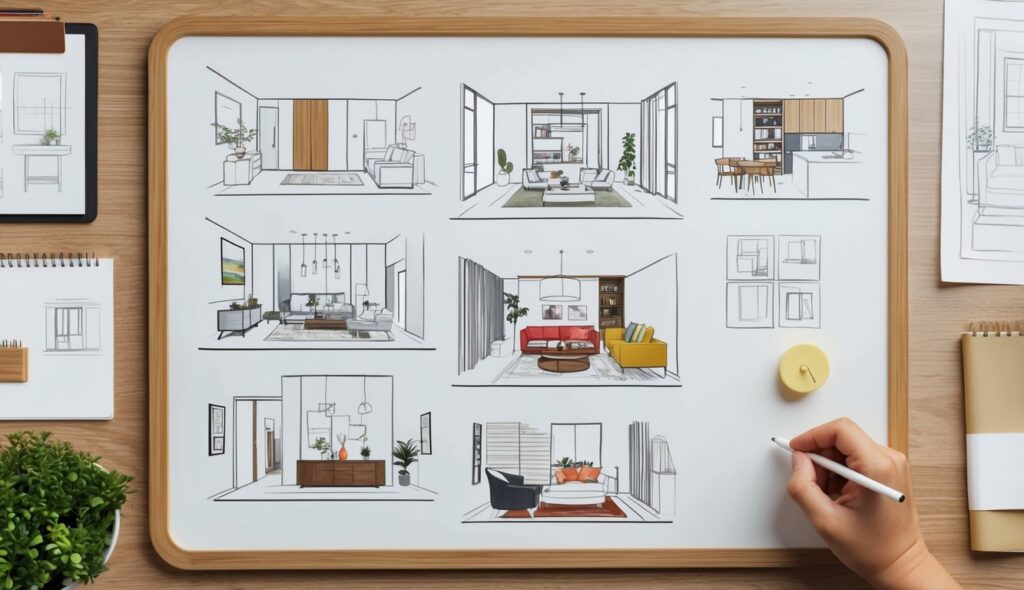Innovative paint technologies are revolutionizing modern architecture, shaping the way we design and construct buildings.
Remember to repin your favorite images!
For instance, Sherwin-Williams Harmony® Paint offers a zero-VOC formula that reduces interior odors and improves indoor air quality by cutting down airborne VOCs post-application.
This focus on sustainability not only aligns with global environmental goals but also provides healthier living and working spaces.
The integration of smart technology into paints is another exciting development.
Innovations like smart paint can change color based on external conditions or even serve as sensors for monitoring structural integrity.
These advanced coatings extend the scope of architectural design, providing solutions that were unimaginable a few decades ago.
Architects are also exploring glow-in-the-dark paints, which utilize phosphorescent pigments to emit light after absorbing energy from a light source.
These paints add both aesthetic and functional value, particularly in public spaces and emergency exits.
Understanding the latest trends, including combination paint-and-primer products, is essential for architects aiming to create sustainable, functional, and visually engaging structures.
Advancements in Paint Formulations
Modern architecture benefits significantly from new paint formulations that enhance buildings’ aesthetics and functionality.
These advancements are driven by innovations in nanotechnology, the use of sustainable materials, and paints with functional properties beyond aesthetics.
Nanotechnology in Coatings
Nanotechnology has revolutionized coatings. By integrating nanoparticles into paint, manufacturers have developed coatings with enhanced durability, scratch resistance, and self-cleaning properties.
These nanoparticles penetrate deeper into the surface, providing stronger adhesion. This results in longer-lasting paint jobs and improved resistance to environmental wear and tear.
For example, nano-coatings can help reduce surface pollution by breaking down organic compounds on contact, making them ideal for exterior applications.
This integration of technology ensures that surfaces remain cleaner for longer, reducing maintenance efforts.
Sustainable and Eco-Friendly Materials
Sustainability is a growing priority in architecture, leading to the development of paints with low or zero volatile organic compounds (VOCs).
Paints like Sherwin-Williams Harmony are designed to improve indoor air quality by reducing airborne VOCs after application, thus creating healthier living environments.
In addition to low-VOC formulations, some paints use natural materials that are biodegradable and non-toxic.
These eco-friendly options not only protect the environment but also contribute to LEED certification for buildings, aligning with green building standards.
Furthermore, manufacturers are exploring bio-based resins and sustainably sourced pigments.
These innovations reduce the environmental impact of paint production and application, promoting more sustainable construction practices.
Functional Properties of Modern Paints
Modern paints offer more than just color.
Self-cleaning paints feature photocatalytic properties that break down dirt and grime using sunlight. This keeps surfaces clean with minimal maintenance.
Antimicrobial paints contain agents that inhibit the growth of bacteria, mold, and mildew.
This is particularly beneficial for high-traffic areas like hospitals, schools, and kitchens, where hygiene is crucial.
Emerging technologies also include self-healing paints that can repair minor scratches and dents automatically, maintaining a pristine appearance over time.
These functional properties extend the lifespan of coatings, reduce maintenance costs, and improve the overall durability of surfaces.
Innovative Applications and Trends
Innovative paint technologies are transforming modern architecture by enhancing health and safety, driving new trends in architectural coatings, and integrating advanced technologies into paint systems.
These advancements are particularly crucial for commercial spaces and sustainable building practices.
Health and Safety Focus
Recent innovations in paint technologies emphasize health and safety.
Antimicrobial paint is becoming increasingly popular, especially in the wake of the COVID-19 pandemic.
These paints contain agents that prevent the growth of bacteria, mold, and viruses. They are especially beneficial in commercial spaces where hygiene is a priority.
By reducing surface contaminants, antimicrobial paints help improve indoor environments significantly.
Additionally, zero-VOC paints like Sherwin-Williams Harmony® paint reduce indoor air pollution.
Such paints improve indoor air quality by reducing airborne volatile organic compounds (VOCs) once they dry. This focus on sustainability and health is reshaping how architects select materials for interior spaces.
Architectural Coating Trends
Architectural coatings are now designed to be more functional and aesthetically pleasing.
Some of the latest trends include smart coatings that can change color or even clean the air.
These coatings are particularly useful for commercial buildings and modern homes, offering both practicality and visual appeal.
Also gaining traction are glow-in-the-dark paints, which find applications in both artistic and functional scenarios.
Such paints use phosphorescent pigments that emit light after being exposed to a light source. This can be especially useful in emergency signage and decorative features.
Technology Integration in Paint Systems
The integration of advanced technologies into paint systems is pushing the boundaries of what paint can do.
Sensor-enabled paints that respond to environmental changes, such as temperature and humidity, are emerging. These smart coatings provide real-time data, which can be useful for building maintenance and energy efficiency.
Moreover, technological advancements allow for innovations like conductive paints, which can be used to create interactive surfaces.
These paints are particularly interesting for their potential in smart homes and commercial spaces that require dynamic, adaptable environments.
For architects, choosing the right paint involves considering these new technologies and trends.
The development of such innovations ensures that architectural projects meet modern demands for sustainability, health, and functionality.
For instance, peel and stick paint samples from Samplize offer a convenient and accurate way to decide on color choices, highlighting the importance of technology in the selection process.

